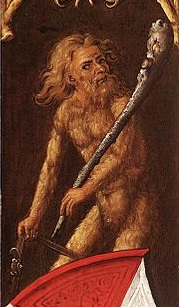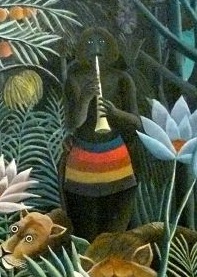On the face of it, a Bigfoot does not seem impossible. There are nonhuman primates living in temperate climates with cold winters: the Japanese macacque. There are nonhuman primates that subsist on a diet of mainly coarse leaves: the langurs. The Cascade Range of the Pacific Northwest still contains vast tracts of remote forest land, much of it closed to human settlement in National Forests and National Parks. It is tempting to think that such a creature could roam those wild places.
The problem is that such legends do not stop with Bigfoot and Yeti. A reading of Wikipedia's "list of cryptids" reveals ape-like or hominid-like creatures reported throughout the world. Some of the stories come from plausible places -- the Orang Pendek of Sumatra (where there are indeed great apes, the orang-utans), and a number of others in Southeast Asia, where inaccessible tropical rainforests do support various primates -- but then there are others in entirely implausible places. Kentish Apeman? Really? There is no real wilderness anywhere in England; even known animals, like the wolf and the bear, have long since been extirpated there. Ohio Grassman? Where would a viable population hide among the numerous towns and rolling farmlands? The one species of large animal in Ohio, the white-tailed deer, is seen and photographed so often by so many, this in itself should be proof enough that there is no place there for an unknown species to hide. Bukit Timah Monkey Man? Bukit Timah is a tiny remnant of rainforest surrounded by the city of Singapore -- it is not large enough to support a population of hominids.
 The "Wild Man" or Woodwose of Medieval iconography is usually depicted as covered with hair, living in the wild places at the edge of civilization, and sometimes as taller than ordinary men. Reported "Wild Man" sightings from those times sometimes expressed doubts as to whether the creatures were human or animal. The parallels with today's Bigfoot lore should be clear.
The "Wild Man" or Woodwose of Medieval iconography is usually depicted as covered with hair, living in the wild places at the edge of civilization, and sometimes as taller than ordinary men. Reported "Wild Man" sightings from those times sometimes expressed doubts as to whether the creatures were human or animal. The parallels with today's Bigfoot lore should be clear.
Naturalist Robert Michael Pyle explained the worldwide persistence of Bigfoot-like legends as fulfilling a need of the human psyche: "We have this need for some larger-than-life creature." But "larger-than-life" may not be the operative characteristic. The Bigfoot legend may be related to another myth: the notion of the "Noble Savage," often attributed to Jean-Jacques Rousseau, though in fact Samuel Dryden used the term a century earlier. In that less-enlightened age when the word "savage" was socially acceptable, men who fancied themselves civilized imagined "savages" as living close to nature, as innocent of the vices of modernity, and (closer to our own times) as having a deep environmental consciousness. What would the "savages" themselves have said about this? Anthropologist Claude LÚvi-Strauss spent many years among the indiginous peoples of the Amazon. Among the recurring themes he found in the myths and legends of many Amazonian peoples was the concept of a sharp division between human and animal, between cultural (cooked, clothed) and natural (raw, naked). They feel the same separation from nature as we.
 Another Rousseau (Henri, not Jean-Jacques) also partook of the idealization of the primitive, though he lived more than half a century after the Rousseau of "Noble Savage" fame. What is this figure from his painting, The Dream? Its features are not human, and, as it is obscured in shadows, it is difficult to tell whether it is covered with fur, or merely has black skin. Yet it is wearing a colorful apron and playing a flute, both distinctly human traits. Is it a "Noble Savage"? A "Wild Man"? A Bigfoot-like creature? Whatever it may be, the nude white woman at the other end of the painting, not shown here, seems to be enjoying its company, despite the presence of two lions at its feet. Perhaps the creature's flute playing charms the lions, rendering them harmless?
Another Rousseau (Henri, not Jean-Jacques) also partook of the idealization of the primitive, though he lived more than half a century after the Rousseau of "Noble Savage" fame. What is this figure from his painting, The Dream? Its features are not human, and, as it is obscured in shadows, it is difficult to tell whether it is covered with fur, or merely has black skin. Yet it is wearing a colorful apron and playing a flute, both distinctly human traits. Is it a "Noble Savage"? A "Wild Man"? A Bigfoot-like creature? Whatever it may be, the nude white woman at the other end of the painting, not shown here, seems to be enjoying its company, despite the presence of two lions at its feet. Perhaps the creature's flute playing charms the lions, rendering them harmless?
Perhaps the ambiguous nature of Rousseau's dream figure -- human or animal, or maybe somewhere in between -- is the true key to the Bigfoot mystery. Humans' sense of alienation from nature probably began as soon as we knew we were human. The Adam and Eve story reflects this: in their Edenic innocence, they felt no separation from nature (represented as God in the story); but what sets humans apart from all other species is our concept of morality, that is, the knowledge of good and evil. Acquiring that knowledge gave us great power over nature, such that in a real sense we were as gods; but that power meant that we had the ability to destroy the Garden, expressed symbolically as the expulsion from Eden. As in the Amazonian myths collected by LÚvi-Strauss, in which nakedness symbolized animality, clothing, humanity, so the same motif in the Adam and Eve story: ashamed of their naked animality, they clothed themselves -- thus emphasizing their alienation from nature, symbolized by God searching, calling out for them. Acquiring the knowledge of good and evil was punished by an irreparable rift between man and nature.
There is no wonder that some people hunt Bigfoot. Bigfoot fulfills a primal longing. Jane Goodall well epressed the conflict between the rational mind and the irrational psyche: on National Public Radio, she first said, "I'm sure they exist." Later she hedged, saying, "Well, I'm a romantic, so I always wanted them to exist", and finally: "You know, why isn't there a body? I can't answer that, and maybe they don't exist, but I want them to." I am a scientist myself; when I walk the woods, all I ever see are exactly the plants and animals known to exist there. So why has my artwork always been full of elves and faeries among the accurately-illustrated greenery? Why have I sometimes wished I could believe in them, even though faerie lore oft portrays them as fearsome creatures who inflict misfortune on humans? Why do I still imagine some remote rainforest tribe living an idyllic life untouched by the modern world, when every ethnography I ever read shows such tribes living with as much worry, suffering, and oppression in their world as we do in ours?
Irish poet W. B. Yeats expressed such longing in "Stolen Child." Between stanzas, the refrain repeats:
"Come away, O human child!Do we not all grow weary of this world full of weeping? Would we not all, at times, like to be free of the burdensome knowledge of good and evil? Elves and faeries were not always friendly toward humans, but as creatures of nature with human-like traits, they represented what we secretly wish we could be.
To the waters and the wild
With a faery hand in hand,
For the world's more full of weeping than you can understand."